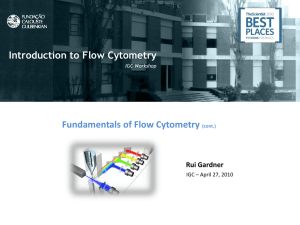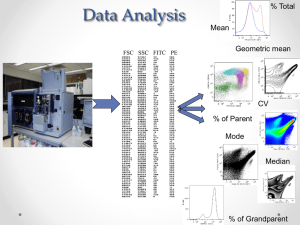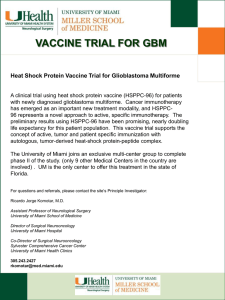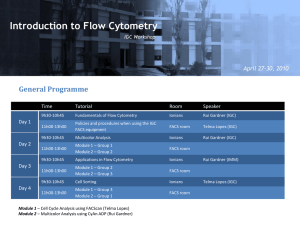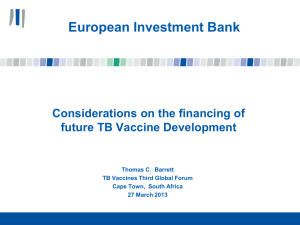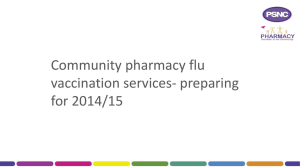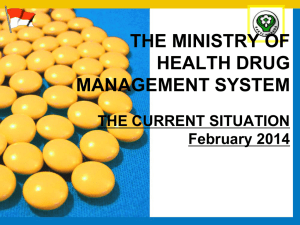He_Flow_Cytometry - Buffalo Ontology Site
advertisement
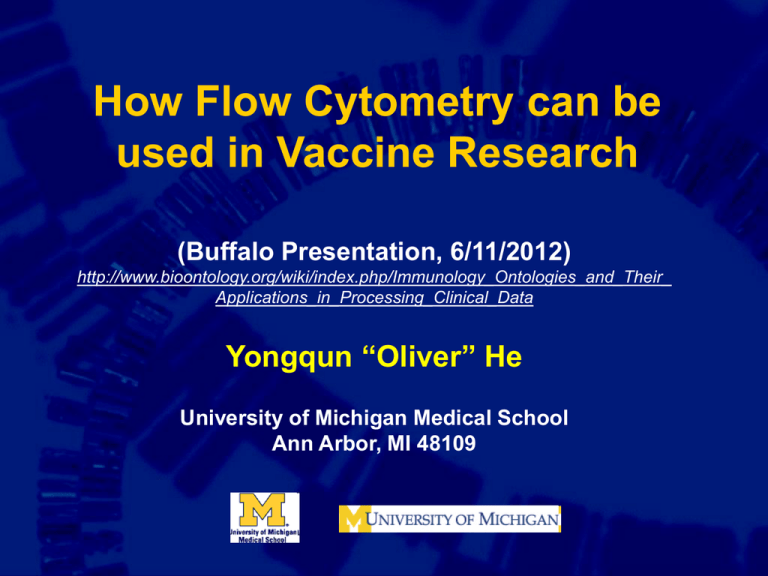
How Flow Cytometry can be used in Vaccine Research (Buffalo Presentation, 6/11/2012) http://www.bioontology.org/wiki/index.php/Immunology_Ontologies_and_Their_ Applications_in_Processing_Clinical_Data Yongqun “Oliver” He University of Michigan Medical School Ann Arbor, MI 48109 Outline I. The applications of flow cytometry in vaccine research i. Introduction of flow cytometry and vaccine research ii. Flow cytometry uses in vaccine research II. III. Ontology representation of flow cytometry in vaccine research i. Possible representation of flow cytometry in OBI/VO for vaccine research ii. Scientific questions to address Challenges What is Flow Cytometry • A technological process that allows for individual measurements of cell fluorescence and light scattering. • Performed at rates of thousands to >10,000 of cells per second. • Can be used to individually sort or separate subpopulations of cells. • Flow cytometry integrates electronics, fluidics, computer, optics, software, and laser technologies in a single platform. Why vaccine research needs flow cytometry? • Vaccine studies are both clinical and basic • Understanding how individuals control disease is crucial to vaccine development • Study behavior of immune cells to discern protective versus harmful reactions. • Vaccines attempt to elicit beneficial responses. • Critical to quantify and characterize immune cells • Fluorescence-activated cell sorting (FACS) is well suited since it simultaneously examines multiple features of immune cells. Bolton and Roederer, 2009. PMID: 19485757 Flow Cytometry Analysis of Vaccines Bolton and Roederer, 2009. PMID: 19485757 Differences of Mechanisms Pathogenesis Immune Defense Adherence to mucosa Mucosal antibody (IgA) Parasites IgE antibody Exotoxin and Endotoxin Neutralizing antibody Viremia Neutralizing antibody Septicemia Opsonizing antibody Intracytoplasmic growth Virus and bacterial replication Cytotoxic T cells (CTL) Type-1 and -2 Interferons Intracellular growth Th1 cytokines Infect epithelial cells Gamma delta T cells Humoral vs. Cellular Immune Responses Humoral: B-cells interact with virus and then differentiate into antibody-secreting plasma cells. CMI: starts with antigen presentation via MHC I and II molecules by dendritic cells, which then leads to activation, proliferation and differentiation of antigen-specific CD4+ or CD8+ T cells. These cells gain effector cell function to help or directly release cytokines, or mediate cytotoxicity following antigen recognition. Ref: http://www.influenzareport.com/ir/pathogen.htm Pathways of Antigen Presentation: Exogenous (MHCII) and Endogenous (MHCI) Use case 1: Analysis of Vaccine Antigen-specific T Cell-Mediated Immunity to Bovine Respiratory Disease Viruses using Flow Cytometry Cells to measure: T Helper cells (CD4+) Cytotoxic T cells (CD8+) Gamma Delta (γδ) T cells (CD25) Refs. Platt, R., W. Burdett, and J. A. Roth. 2006. Induction of antigen specific T cell subset activation to bovine respiratory disease viruses by a modified-live virus vaccine. Am J Vet Res, 67:1179-1184, 2006. James A. Roth presentation: http://www.ars.usda.gov/SP2UserFiles/Place/36253000/BVD2005/12_Denver BVDmtg2006.pdf Changes of cell markers after T Cell Activation Unstimulated cells T-c Activated cells Antigen T-c stimulation Regular cell surface markers Various Cytokines CD25 (IL-2R, IL-2 receptor alpha chain) Ref: James A. Roth presentation: http://www.ars.usda.gov/SP2UserFiles/Place/36253000/BVD2005/12_DenverBVDmtg2006.pdf Multi-protein Flow Cytometry General Strategy: Measures the expression of CD25, intracellular IFN- and IL-4 in T cell subsets. After incubation of PBMCs with antigens for days, cells are strains for cell surface markers and intracellular cytokines and analyzed by flow cytometry. Ref: James A. Roth presentation: http://www.ars.usda.gov/SP2UserFiles/Place/36253000/ BVD2005/12_DenverBVDmtg2006.pdf CD25 T IL-4 CD4 CD8 T IFN T Use case 2: YF17D as Yellow fever vaccine induces integrated multilineage and polyfunctional immune responses • YF17D: yellow fever (YF) vaccine 17D • Functional genomics and polychromatic flow cytometry to define the signature of the immune response to YF17D in a cohort of 40 volunteers followed for up to 1 year after vaccination. Reference: Gaucher D, et al. Yellow fever vaccine induces integrated multilineage and polyfunctional immune responses. J Exp Med. 2008 Dec 22;205(13):3119-31. PMID: 19047440. DCs pulsed with YF17D virus (live or UVinactivated) primed a strong antigen-specific response of naive T cells with up to 4% cells expressing CD154 and IFN-g in response to live or UV-inactivated YF17D. Ref: Gaucher D, et al. J Exp Med. 2008. 205(13):3119-31. PMID: 19047440 Use case 3: Brucella cattle vaccine RB51 induces caspase-2-mediated programmed cell death of macrophages and dendritic cells (DCs) (my own lab research) • RB51, but not its parent virulent strain S2308, induces caspase-2-mediated macrophage cell death • RB51 and S2308 both induce cell death in DCs. Reference: Chen F, He Y. Caspase-2 mediated apoptotic and necrotic murine macrophage cell death induced by rough Brucella abortus. PLoS One. 2009 Aug 28;4(8):e6830 Brucella-induced macrophage cell death: Apoptosis, necrosis, or pyroptosis? Apoptosis Pyroptosis Rough Brucellainduced M death Inflammatory - + + Caspase-1 ? + - Caspase-2 + ? + So, it’s a novel cell death pathway!! Proposed name: Caspase-2-mediated pyroptosis? Bergsbaken et al. Nat Rev Microbiol. 2009;7(2):99-109. • Question: Can caspase-2 mediates antigen presentation? Use case 3: RB51 also induces caspase2-mediated programmed cell death of dendritic cells (my own lab research) • RB51, but not its parent virulent strain 2308, induces caspase-2-mediated DC activation • Flow cytometry markers: CD40, CD80, CD86, MHC class I and II. Outline I. The applications of flow cytometry in vaccine research i. Introduction of flow cytometry and vaccine research ii. Flow cytometry uses in vaccine research II. III. Ontology representation of flow cytometry in vaccine research i. Possible representation of flow cytometry in OBI/VO for vaccine research ii. Scientific questions to address Challenges OBI/PRO/CL/VO Representation of Vaccine Flow Cytometry Data • Ontology uses for vaccine data standardization: o OBI for medical investigations o PRO for proteins; o CL for cell types, CLO for cell lines o VO for vaccines • Melanie will present an overview of the representation of flow cytometry assays in OBI • VO can be used in combination with OBI to represent how flow cytometry can be used in vaccine research. Capturing Vaccine Flow Cytometry -derived Knowledge in VO • Interesting stories for VO representation: o What’s unique in vaccine-stimulated cell molecular markers o Why are they unique and critical? o Pathways of the induction of cell types with the markers. • Collaboration among ontology teams is key to make the story successful Challenges • There has no centralized flow cytometry data repository like GEO and ArrayExpress for microarray data • How to use ontologies to analyze vaccine flow cytometry data needs demonstrations. • Why adding ontologies benefit? References 1) Bolton DL, Roederer M. Flow cytometry and the future of vaccine development. Expert Rev Vaccines. 2009 Jun;8(6):779-89. Review. PMID: 19485757 2) Diane L. Bolton and Mario Roederer. Flow cytometry and the future of vaccine development. Expert Rev Vaccines. 2009. 8(6), 779-789. PMID: 19485757. 3) Gaucher D, et al. Yellow fever vaccine induces integrated multilineage and polyfunctional immune responses. J Exp Med. 2008 Dec 22;205(13):311931. PMID: 19047440.

